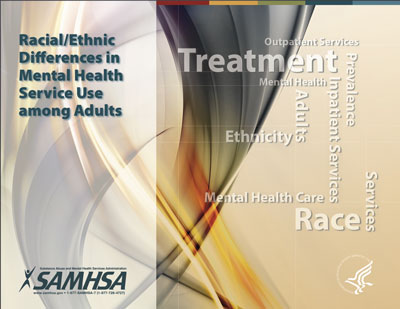NIMH · A New Look at Racial/Ethnic Differences in Mental Health Service Use Among Adults
April 23, 2015 • Science Update
New findings on mental health service use by racial and ethnic groups are now available in a report by the Substance Abuse and Mental Health Services Administration (SAMHSA). “This is a wonderful resource,” said Pamela Collins, MD, NIMH director of the Office for Research on Disparities & Global Mental Health. “These findings will help us identify who is not getting the services they need and where the hurdles lie.”
The report, “Racial/Ethnic Differences in Mental Health Service Use among Adults,” is based on combined National Survey on Drug Use and Health (NSDUH) data from 2008 to 2012. Researchers looked at how often adults in different racial and ethnic groups sought mental health services in the past year. Findings include estimates of overall service use, medication use, outpatient and inpatient service use, as well as reasons for not using services.
The adults most likely to use mental health services in the past year (17.1%) were in the group reporting two or more races. This group was followed by white adults (16.6%), American Indian or Alaska Native adults (15.6%), followed by black (8.6), Hispanic (7.3) and Asian (4.9%) adults.
The racial/ethnic groups most likely to use a prescription for psychiatric medication were white adults (14.4%), adults reporting two or more races (14.1%), and American Indian or Alaska Native adults (13.6%), followed by black (6.5%), Hispanic (5.7%), and Asian (3.1%) adults.
Using outpatient mental health services in the past year was most common for adults reporting two or more races (8.8%), white adults (7.8%), and American Indian or Alaska Native adults (7.7%), followed by black (4.7%), Hispanic (3.8%), and Asian (2.5%) adults.
Using inpatient mental health services in the past year was more common among black adults (1.4%) than white adults (0.7%).
Cost of services / lack of insurance coverage was the most common reason for not using mental health services across all racial/ethnic groups. Believing that mental health services would not help was the least cited reason across all racial/ethnic groups.
A downloadable copy of “Racial/Ethnic Differences in Mental Health Service Use among Adults” is available on the SAMHSA website. The main report is here . The appendices are here .
via NIMH · A New Look at Racial/Ethnic Differences in Mental Health Service Use Among Adults.
